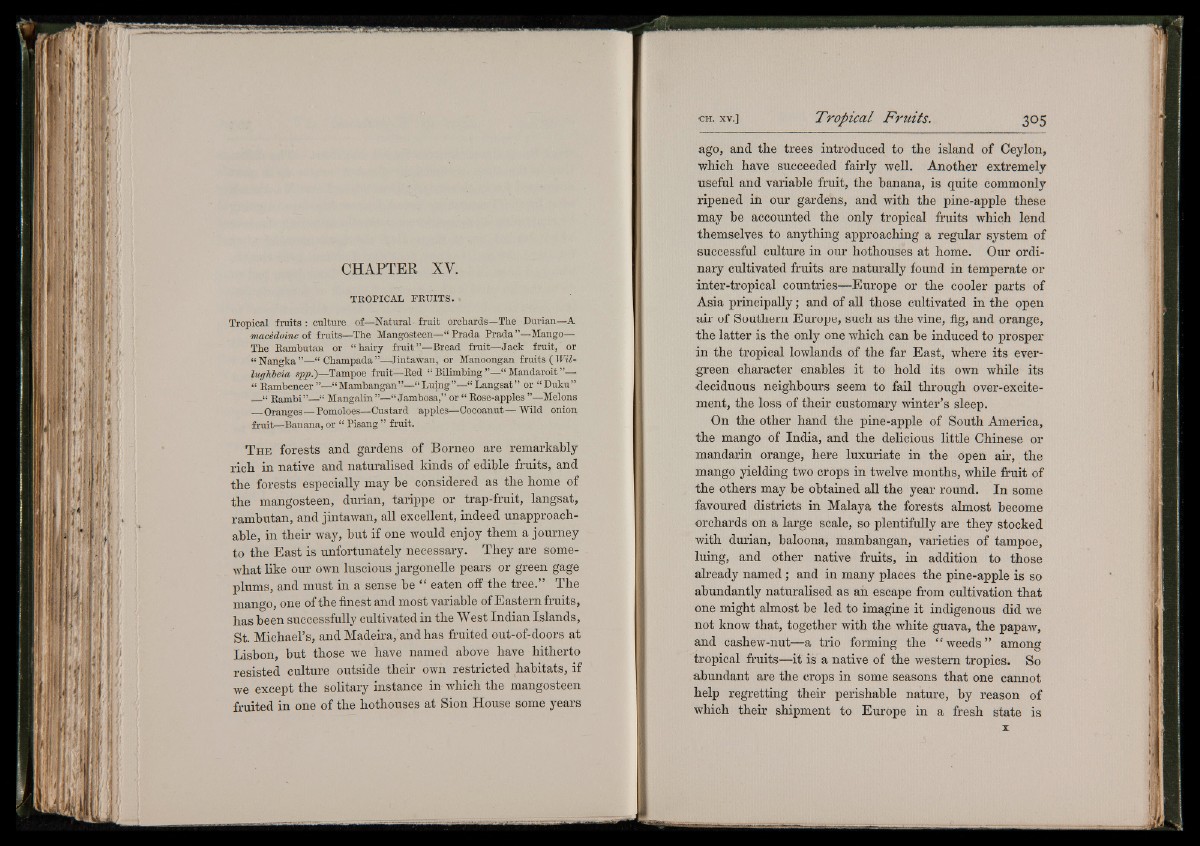
CHAPTER XV.
TROPICAL FRU ITS . .
Tropical fruits: culture of—Natural fruit orchards—The Durian—A
macedoine of fruits—The Mangosteen—“ Prada Prada”—Mango—
The Rambutan or “ hairy fruit ’’—Dread fruit—jack fruity or
“ Nangka ”#§“ Champada ”—Jintawan, or Manoongan fruits ( WiU
lughbeia spp.)—Tampoe fruit—Red jg Bilimbing § Mandaroit ”—
“ Rambeneer”—“Mambangan’’—“Luing’’—“Langsat” or “Duku”
“ Rambi”—“ Mangalin”—“ Jambosa,” or “ Rose-apples ’’—Melons
Oranges Pomoloes—Custard apples—Cocoanut— Wild onion
fruit—Banana, or “ Pisang ” fruit.
T h e forests and gardens of Borneo are remarkably
rick in native and naturalised kinds of edible fruits, and
the forests especially may be considered as the home of
the mangosteen, durian, tarippe or trap-fruit, langsat,
rambutan, and jintawan, all excellent, indeed unapproachable,
in their way, but if one would enjoy them a journey
to the East is unfortunately necessary. They are somewhat
like our own luscious jargonelle pears or green gage
plums, and must in a sense be “ eaten off the tree.” The
m a n g o , one of the finest and most variable of Eastern fruits,
has been successfully cultivated in the West Indian Islands,
St. Michael’s, and Madeira,’and has fruited out-of-doors at
Lisbon, but those we have named above have hitherto
resisted culture outside their own restricted habitats, if
we except the solitary instance in which the mangosteen
fruited in one of the hothouses at Sion House some years
ago, and the trees introduced to the island of Ceylon,
which have succeeded fairly well. Another extremely
useful and variable fruit, the banana, is quite commonly
ripened in our gardens, and with the pine-apple these
may be accounted the only tropical fruits which lend
themselves to anything approaching a regular system of
successful culture in our hothouses at home. Our ordinary
cultivated fruits are naturally found in temperate or
inter-tropical countries—Europe or the cooler parts of
Asia principally; and of all those cultivated in the open
air of Southern Europe, such as the vine, fig, and orange,
the latter is the only one which can be induced to prosper
in the tropical lowlands of the far East, where its evergreen
character enables it to hold its own while its
deciduous neighbours seem to fail through over-excitement,
the loss of their customary winter’s sleep.
On the other hand the pine-apple of South America,
the mango of India, and the delicious little Chinese or
mandarin orange, here luxuriate in the open ah’, the
mango yielding two crops in twelve months, while fruit of
the others may be obtained all the year round. In some
favoured districts in Malaya the forests almost become
orchards on a large scale, so plentifully are they stocked
with durian, baloona, mambangan, varieties of tampoe,
luing, and other native fruits, in addition to those
already named; and in many places the pine-apple is so
abundantly naturalised as ah escape from cultivation that
one might almost be led to imagine it indigenous did we
not know that, together with the white guava, the papaw,
and cashew-nut—a trio forming the “ weeds” among
tropical fruits—it is a native of the western tropics. So
abundant are the crops in some seasons that one cannot
help regretting their perishable nature, by reason of
which their shipment to Europe in a fresh state is